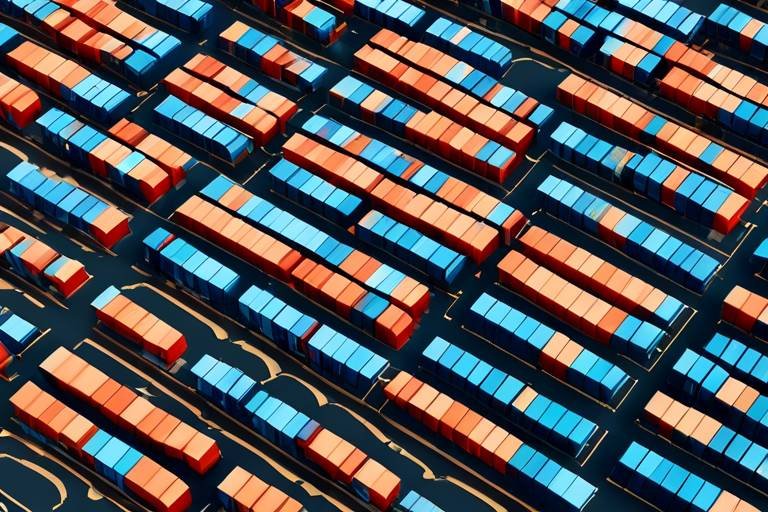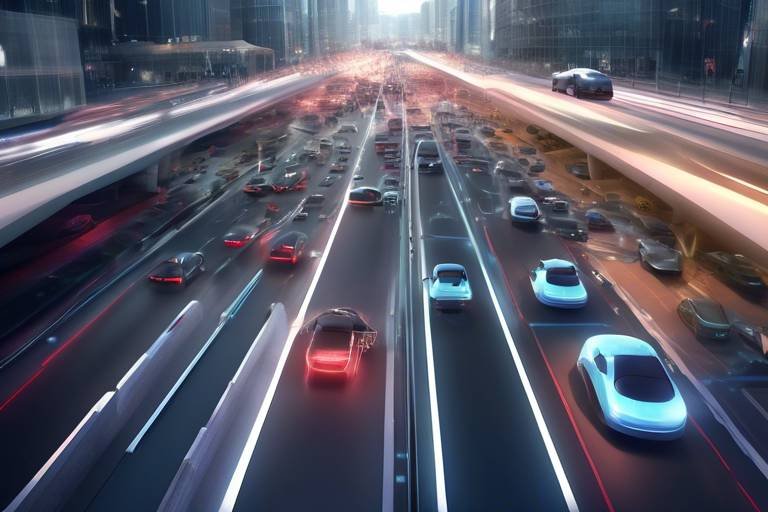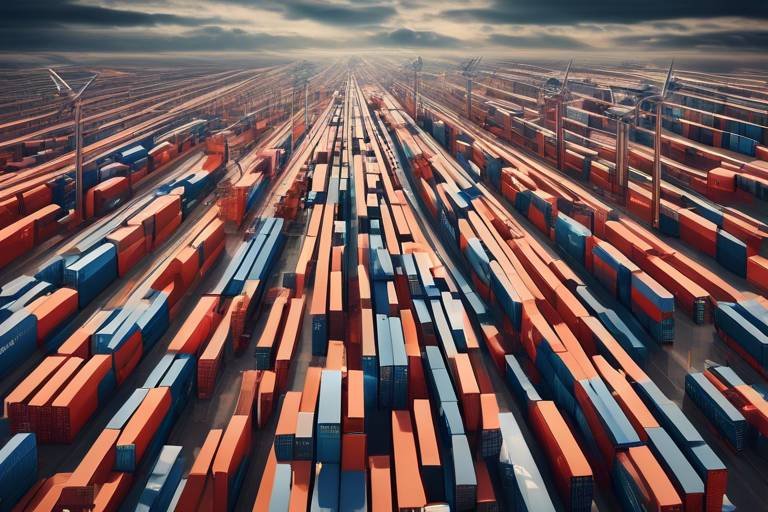The Future of Biodegradable Plastics
In a world increasingly burdened by plastic waste, the emergence of biodegradable plastics is a beacon of hope. These innovative materials are not just a trend; they represent a significant shift in how we approach sustainability. Imagine a future where plastic waste doesn’t linger in landfills for centuries, but instead, decomposes naturally, returning to the earth. This article explores the advancements, challenges, and potential impacts of biodegradable plastics on the environment and industry, highlighting their role in sustainable development and waste management.
Innovations in biodegradable plastics are rapidly evolving, with new materials and technologies emerging that promise to reduce environmental impact while maintaining functionality and durability for various applications. Companies are now experimenting with plant-based materials, such as cornstarch and sugarcane, which can be transformed into robust packaging solutions. These advancements are not just about replacing traditional plastics; they are about creating a new paradigm in material science that prioritizes the planet. For instance, some new biodegradable plastics can decompose in industrial composting facilities within a few months, compared to the hundreds of years traditional plastics require.
Biodegradable plastics offer significant environmental advantages, including reduced landfill waste, lower carbon emissions, and the potential to minimize pollution in oceans and waterways, contributing to a healthier ecosystem. By using biodegradable materials, we can drastically cut down on the volume of plastic that ends up in our oceans, where it harms marine life and disrupts ecosystems. Moreover, these materials can help in reducing our carbon footprint. For example, when biodegradable plastics break down, they often emit fewer greenhouse gases compared to their conventional counterparts. This is a crucial step towards achieving a more sustainable future.
Understanding the differences between biodegradable and traditional plastics is crucial. Traditional plastics are derived from fossil fuels and can take hundreds of years to decompose, leading to environmental degradation. In contrast, biodegradable plastics are designed to break down more quickly and safely. Here’s a quick comparison:
| Feature | Biodegradable Plastics | Traditional Plastics |
|---|---|---|
| Source | Renewable resources (e.g., corn, sugarcane) | Fossil fuels |
| Decomposition Time | Months to a few years | Hundreds of years |
| Environmental Impact | Lower emissions, less landfill waste | High emissions, significant landfill contribution |
The mechanisms by which biodegradable plastics break down are varied. They can decompose through biological, chemical, and physical processes. For example, some biodegradable plastics require specific conditions, such as moisture and temperature, to break down effectively. Others might rely on microorganisms to facilitate decomposition. Understanding these processes is essential for optimizing their use in various environments, from home composting to industrial facilities.
A life cycle analysis of biodegradable plastics reveals insights into their overall sustainability. This analysis evaluates the environmental footprint from production to disposal, contrasting it with conventional plastic products. While biodegradable plastics may require more energy to produce initially, their overall impact can be significantly lower when considering their end-of-life scenarios. This holistic view is crucial for making informed decisions about material usage in industries ranging from packaging to consumer goods.
Despite their benefits, the widespread adoption of biodegradable plastics faces challenges. One of the primary hurdles is the production costs, which can be higher than those of traditional plastics. Additionally, consumer awareness is still lacking; many people are unsure about the proper disposal methods for biodegradable plastics, which can lead to contamination in recycling streams. Furthermore, the current disposal infrastructure is often inadequate, meaning that even biodegradable plastics can end up in landfills where they cannot break down effectively. Addressing these challenges is crucial for the future success of biodegradable plastics.
The development of regulations and standards for biodegradable plastics is essential for ensuring safety and effectiveness. As the market grows, governments and organizations are beginning to establish guidelines that help consumers make informed choices. These regulations also encourage manufacturers to adopt sustainable practices, ensuring that the biodegradable plastics produced meet specific environmental criteria.
Various global initiatives and policies are being implemented to encourage the use of biodegradable plastics. Programs such as the European Union's Single-Use Plastics Directive aim to reduce plastic waste by promoting alternatives like biodegradable materials. These initiatives not only impact industry practices but also raise awareness among consumers about the importance of reducing plastic waste.
Research in biodegradable plastics is continuously evolving, with new trends emerging. Scientists are exploring innovative materials, such as mycelium-based plastics and algae-derived biopolymers, which could redefine sustainability in the plastic industry. As technology advances, we can anticipate even more efficient and eco-friendly materials that serve the same functions as traditional plastics but with a much lower environmental impact.
- What are biodegradable plastics made from? Biodegradable plastics are typically made from renewable resources like corn starch, sugarcane, or even certain types of algae.
- How long do biodegradable plastics take to decompose? Depending on the type and environmental conditions, biodegradable plastics can decompose in a matter of months to a few years.
- Can biodegradable plastics be recycled? It depends on the local recycling facilities. Some biodegradable plastics can contaminate recycling streams, so it’s essential to check local guidelines.
- Are biodegradable plastics a complete solution to plastic pollution? While they offer significant benefits, they are not a panacea. Proper disposal and consumer awareness are crucial for their effectiveness.

Current Innovations in Biodegradable Plastics
In recent years, the world has witnessed a remarkable surge in innovations surrounding biodegradable plastics. These advancements are not just a fleeting trend; they represent a significant shift in how we approach plastic production and waste management. Researchers and companies alike are diving deep into the science of materials, exploring alternatives that promise to be both functional and environmentally friendly. From plant-based polymers to novel additives that enhance biodegradability, the landscape is changing rapidly.
One of the most exciting developments is the creation of bio-based plastics derived from renewable resources such as corn starch, sugarcane, and even agricultural waste. These materials are designed to mimic the properties of traditional plastics while offering a much lower carbon footprint. For instance, polylactic acid (PLA) is a popular choice that is not only biodegradable but also compostable under the right conditions. This means that when disposed of properly, PLA can break down into natural components, nourishing the soil instead of polluting it.
Moreover, researchers are experimenting with new additives that can be blended with conventional plastics to enhance their biodegradability. These additives can accelerate the breakdown process, allowing plastics to decompose more quickly in landfills or marine environments. The integration of enzymes and microbes into plastic materials is a fascinating area of study, as these biological agents can significantly speed up degradation rates. Imagine a plastic bag that can dissolve in a matter of months instead of centuries!
Another innovative approach involves the development of self-degrading plastics. These materials are engineered to break down upon exposure to specific environmental triggers, such as UV light or moisture. This technology not only helps in reducing plastic waste but also ensures that products do not linger in the environment longer than necessary. The potential applications for self-degrading plastics are vast, ranging from packaging to agricultural films.
As we look toward the future, the focus is not just on creating biodegradable plastics but also on ensuring that they are cost-effective and scalable. Companies are investing in research and development to streamline production processes, aiming to make biodegradable options as affordable as their traditional counterparts. This shift is crucial for widespread adoption, as consumers are more likely to choose sustainable options if they do not have to pay a premium for them.
In summary, the innovations in biodegradable plastics are paving the way for a more sustainable future. As these materials continue to evolve, they hold the promise of significantly reducing our reliance on conventional plastics and their detrimental effects on the environment. The journey is just beginning, and with ongoing research and development, we can expect to see even more groundbreaking solutions emerge in the coming years.
- What are biodegradable plastics made from? Biodegradable plastics can be made from natural materials such as corn starch and sugarcane, as well as synthetic materials designed to break down more easily.
- How long does it take for biodegradable plastics to decompose? The decomposition time varies depending on the type of biodegradable plastic and environmental conditions, ranging from a few months to several years.
- Can biodegradable plastics be recycled? While some biodegradable plastics can be recycled, it is essential to check local recycling guidelines, as many facilities are not equipped to handle them.
- Are biodegradable plastics better for the environment? Yes, biodegradable plastics typically have a lower environmental impact than traditional plastics, as they can reduce landfill waste and pollution when disposed of properly.

Environmental Benefits of Biodegradable Plastics
Biodegradable plastics are not just a passing trend; they represent a significant shift towards sustainable practices that can dramatically alter our environmental landscape. These innovative materials come with a host of environmental benefits that could help mitigate the negative impacts of traditional plastics. One of the most compelling advantages is their ability to reduce landfill waste. Unlike conventional plastics, which can take hundreds of years to decompose, biodegradable plastics are designed to break down more quickly, thereby lessening the burden on our already overflowing landfills.
Moreover, the production of biodegradable plastics often results in lower carbon emissions. Many of these materials are derived from renewable resources, such as corn starch or sugarcane, which means that their lifecycle contributes less to greenhouse gas emissions compared to fossil fuel-based plastics. This is crucial in our fight against climate change, as every reduction in carbon output can have a ripple effect on global temperatures and weather patterns.
Another critical benefit is the potential to minimize pollution in oceans and waterways. Plastic waste is a notorious contributor to marine pollution, harming wildlife and disrupting ecosystems. Biodegradable plastics can significantly reduce this risk, as they are designed to decompose in marine environments, thus lessening the chance of entanglement or ingestion by marine animals. Imagine a world where our oceans are free from the shackles of plastic debris; biodegradable plastics could be a key player in making this vision a reality.
To further illustrate the environmental advantages, consider the following table that compares the environmental impact of biodegradable plastics versus traditional plastics:
| Aspect | Traditional Plastics | Biodegradable Plastics |
|---|---|---|
| Decomposition Time | Hundreds of years | Months to a few years |
| Source Material | Fossil fuels | Renewable resources |
| Carbon Emissions | High | Lower |
| Impact on Marine Life | High risk of entanglement and ingestion | Lower risk, designed to decompose |
In summary, the environmental benefits of biodegradable plastics are not just theoretical; they offer practical solutions to some of the most pressing challenges we face today. By opting for biodegradable alternatives, we can significantly reduce landfill waste, lower carbon emissions, and protect our precious marine ecosystems. The question remains: will we embrace these innovative materials and pave the way for a more sustainable future?
- What are biodegradable plastics made from? Biodegradable plastics are often made from renewable resources like corn starch, sugarcane, or other plant-based materials.
- How long does it take for biodegradable plastics to decompose? Depending on the type and environmental conditions, biodegradable plastics can take anywhere from a few months to a couple of years to decompose.
- Are biodegradable plastics safe for the environment? Yes, when disposed of properly, biodegradable plastics can significantly reduce pollution and harm to wildlife compared to traditional plastics.
- Can biodegradable plastics be recycled? It depends on local recycling facilities. Some biodegradable plastics can be composted, while others may not be accepted in standard recycling programs.

Comparison with Traditional Plastics
When we talk about biodegradable plastics, it’s essential to understand how they stack up against their traditional counterparts. Traditional plastics, made from petroleum-based materials, have been a staple in our society for decades. However, they come with a hefty price tag for the environment. In contrast, biodegradable plastics are designed to break down more quickly and efficiently, which can significantly mitigate the negative impacts associated with plastic waste.
One of the most notable differences lies in their production processes. Traditional plastics are derived from fossil fuels, a non-renewable resource that contributes to carbon emissions and environmental degradation. On the other hand, biodegradable plastics can be made from renewable resources like corn starch, sugarcane, or even food waste. This shift not only helps reduce our reliance on fossil fuels but also promotes a more circular economy.
Now, let’s dive into the degradation timelines. Traditional plastics can take hundreds of years to decompose, often breaking down into microplastics that pollute our oceans and waterways. Biodegradable plastics, however, can break down in a matter of months to a few years, depending on the environmental conditions. This rapid decomposition is crucial for reducing landfill waste and minimizing pollution.
To illustrate the differences further, consider the following table:
| Aspect | Traditional Plastics | Biodegradable Plastics |
|---|---|---|
| Source Material | Fossil Fuels | Renewable Resources |
| Decomposition Time | Hundreds of years | Months to a few years |
| Environmental Impact | High (landfill, microplastics) | Lower (reduced waste, less pollution) |
Despite these advantages, it’s important to note that biodegradable plastics are not a one-size-fits-all solution. They require specific conditions to decompose effectively, such as heat and moisture, which may not be present in all environments. This means that while they offer a better alternative, they still need proper disposal methods to ensure they fulfill their promise of sustainability.
In summary, comparing biodegradable plastics with traditional plastics reveals significant differences in their environmental impact, production processes, and degradation timelines. As we navigate the complexities of waste management and environmental sustainability, understanding these distinctions is crucial for making informed choices that benefit both our planet and future generations.
- What are biodegradable plastics made from? Biodegradable plastics can be made from renewable resources such as corn starch, sugarcane, or other organic materials.
- How long do biodegradable plastics take to decompose? Depending on the conditions, biodegradable plastics can break down in a matter of months to a few years.
- Can biodegradable plastics be recycled? It depends on the type of biodegradable plastic and local recycling capabilities. Some biodegradable plastics can be composted, while others may not be suitable for traditional recycling processes.

Degradation Processes Explained
Understanding the degradation processes of biodegradable plastics is like peeling an onion—there are multiple layers that reveal how these materials break down in various environments. Unlike traditional plastics, which can linger in our ecosystems for hundreds of years, biodegradable plastics are designed to decompose more rapidly under the right conditions. This decomposition can be facilitated through a combination of biological, chemical, and physical processes, each playing a crucial role in ensuring that these materials do not contribute to long-term pollution.
At the core of biodegradable plastics are natural polymers derived from renewable resources, such as starch, cellulose, and polylactic acid (PLA). These materials are engineered to be more susceptible to environmental factors. The degradation process typically begins when microorganisms, such as bacteria and fungi, recognize these materials as a food source. Once these microbes come into contact with biodegradable plastics, they begin to break down the polymer chains through enzymatic action. This biological process is often the most efficient method of decomposition.
However, not all biodegradable plastics are created equal. The conditions under which they degrade can vary significantly. For instance, some biodegradable plastics require industrial composting facilities to break down effectively, as they need specific temperatures and humidity levels to accelerate the degradation process. On the other hand, certain types of biodegradable plastics can decompose in home composting systems or even in soil, making them more versatile for everyday use.
In addition to biological processes, chemical and physical factors also play a role in the degradation of these materials. For example, exposure to UV light can help to break down some biodegradable plastics, leading to photodegradation. Similarly, mechanical processes such as grinding or shredding can increase the surface area of the material, allowing microorganisms to access the polymer chains more easily and thus speeding up the degradation.
To give you a clearer picture, here's a simple table that outlines the different degradation processes:
| Degradation Process | Description | Conditions Required |
|---|---|---|
| Biodegradation | Breakdown by microorganisms into natural substances | Moisture, temperature, and microbial presence |
| Chemical Degradation | Breakdown through chemical reactions, including hydrolysis | Presence of water and certain chemical agents |
| Photodegradation | Breakdown caused by exposure to UV light | Sunlight exposure |
| Thermal Degradation | Decomposition due to high temperatures | High heat environments |
Ultimately, the effectiveness of biodegradable plastics in reducing waste hinges on the proper conditions for their degradation. Without the right environment, these materials may not break down as intended, which can lead to confusion and skepticism about their efficacy. As we move toward a more sustainable future, it’s essential to understand these degradation processes and how they can be harnessed to minimize our environmental footprint.
- What are biodegradable plastics made from? Biodegradable plastics are typically made from natural polymers such as starch, cellulose, and polylactic acid (PLA).
- How long does it take for biodegradable plastics to decompose? The decomposition time can vary significantly, ranging from a few weeks in industrial composting facilities to several months or years in natural environments, depending on the type of plastic and conditions present.
- Can biodegradable plastics break down in landfills? While biodegradable plastics can break down in landfills, they often require specific conditions that are not typically found in landfill environments, which can hinder their degradation.
- Are biodegradable plastics a solution to plastic pollution? They can be part of the solution, but proper disposal and composting practices are crucial to ensure their effectiveness in reducing plastic pollution.

Life Cycle Analysis
The concept of Life Cycle Analysis (LCA) is pivotal in understanding the sustainability of biodegradable plastics. It encompasses the entire journey of a product, from raw material extraction through production, usage, and finally, to disposal. This comprehensive approach allows us to gauge the environmental impacts associated with each stage of a product's life. For biodegradable plastics, this analysis is particularly crucial, as it helps to illuminate not just their benefits but also their potential drawbacks when compared to traditional plastics.
At the outset, the LCA of biodegradable plastics begins with the sourcing of raw materials. Many biodegradable plastics are derived from renewable resources, such as corn starch or sugarcane, which can significantly reduce the carbon footprint compared to petroleum-based plastics. However, the cultivation of these crops can lead to land use changes, water consumption, and pesticide use, which must be factored into the analysis. The following table summarizes the key stages of the life cycle for biodegradable plastics:
| Life Cycle Stage | Environmental Impact |
|---|---|
| Raw Material Extraction | Potential land use changes and resource depletion |
| Production | Lower emissions compared to traditional plastics, but energy-intensive processes |
| Usage | Performance similar to traditional plastics, but with limited shelf life in some cases |
| Disposal | Biodegradable potential, but requires specific conditions for effective degradation |
As we move to the production phase, it's essential to note that while biodegradable plastics generally have a smaller carbon footprint during their manufacture, the processes involved can still be energy-intensive. This phase often involves the use of various chemicals and additives, which can have their own environmental impacts. The usage stage, where these materials are employed in everyday products, typically mirrors that of traditional plastics in terms of functionality. However, the degradation phase is where biodegradable plastics shine—or falter, depending on the context.
For biodegradable plastics to truly fulfill their promise, they must degrade effectively in the right environments, such as composting facilities. Unfortunately, many end up in landfills, where the conditions are not optimal for decomposition, leading to questions about their overall efficacy. This scenario highlights the importance of proper waste management infrastructure, which is often lacking in many regions.
In conclusion, a thorough Life Cycle Analysis reveals that while biodegradable plastics offer a more sustainable alternative to traditional plastics, they are not without their challenges. Understanding these complexities is crucial for consumers, manufacturers, and policymakers alike as they work towards a more sustainable future. By addressing the full life cycle, we can make informed decisions that truly benefit our environment.
- What is Life Cycle Analysis? Life Cycle Analysis is a systematic approach to evaluating the environmental impacts of a product throughout its entire life cycle, from raw material extraction to disposal.
- Are biodegradable plastics always better for the environment? Not necessarily. While they have benefits, their environmental impact depends on various factors, including how they are produced and disposed of.
- Can biodegradable plastics decompose in landfills? Generally, biodegradable plastics require specific conditions to break down effectively, which are often not present in landfills.
- What materials are commonly used to make biodegradable plastics? Common materials include corn starch, sugarcane, and other renewable resources.

Challenges in Adoption
Despite the promising benefits of biodegradable plastics, their widespread adoption is not without significant challenges. One of the most pressing issues is the production cost. Biodegradable plastics often require more advanced technologies and raw materials compared to traditional plastics, which can lead to higher prices. This can deter manufacturers from switching to more sustainable options, especially when consumers are still price-sensitive and may not prioritize environmental concerns over cost.
Another challenge lies in consumer awareness. Many people are still unaware of the existence and benefits of biodegradable plastics. Without adequate information, consumers may continue to choose conventional plastics, thinking they are the only available option. This lack of awareness can hinder market demand for biodegradable alternatives, making it difficult for companies to justify the investment in production.
Furthermore, the disposal infrastructure for biodegradable plastics is often lacking. While these materials are designed to break down in specific conditions, many waste management systems are not equipped to handle them properly. For instance, biodegradable plastics typically require industrial composting facilities to decompose effectively. However, such facilities are not universally available, leading to a situation where these materials may end up in landfills, where they do not degrade as intended.
There are also regulatory hurdles that need to be addressed. In many regions, existing regulations do not differentiate between biodegradable plastics and traditional plastics, which can lead to confusion and mismanagement. The absence of clear guidelines can discourage manufacturers from investing in biodegradable options, fearing that they may not meet the necessary standards or that their products may be misclassified.
Lastly, the performance of biodegradable plastics in various applications is still a concern for many industries. While advancements have been made, some biodegradable materials may not yet match the durability and effectiveness of their conventional counterparts. This can lead to hesitation from businesses that rely on high-performance materials, as they may fear that switching to biodegradable options could compromise their product quality.
To sum it up, the challenges in adopting biodegradable plastics are multi-faceted, encompassing economic, educational, infrastructural, regulatory, and performance-related issues. Addressing these challenges requires a concerted effort from manufacturers, consumers, and policymakers alike. Only through collaboration and innovation can we hope to overcome these obstacles and pave the way for a more sustainable future.
- What are biodegradable plastics? Biodegradable plastics are materials designed to break down more quickly than traditional plastics, typically through biological processes.
- How do biodegradable plastics differ from traditional plastics? The primary difference lies in their decomposition process; biodegradable plastics can decompose under specific conditions, while traditional plastics can take hundreds of years to break down.
- Are biodegradable plastics more expensive? Generally, yes. The production of biodegradable plastics can be more costly due to the materials and technologies involved.
- Can biodegradable plastics be recycled? It depends on the type of biodegradable plastic and local recycling capabilities. Many biodegradable plastics require industrial composting rather than traditional recycling methods.
- What can be done to promote the use of biodegradable plastics? Increasing consumer awareness, improving disposal infrastructure, and developing clear regulations can help boost the adoption of biodegradable plastics.

Regulatory Framework and Standards
As the world grapples with the pressing issue of plastic pollution, the establishment of a robust regulatory framework for biodegradable plastics has become increasingly vital. Governments and organizations worldwide are recognizing the need to create clear guidelines that ensure these materials are both effective and safe for the environment. The regulatory landscape is evolving, and it is essential to understand the various standards that are emerging.
Currently, several standards exist to classify and regulate biodegradable plastics, ensuring they meet specific criteria for environmental safety and performance. For instance, the ASTM D6400 and EN 13432 are two prominent standards that outline the requirements for biodegradable and compostable plastics. These standards stipulate that materials must decompose within a certain timeframe under controlled conditions, leaving behind no toxic residue. This is crucial for fostering consumer trust and promoting the adoption of biodegradable alternatives.
However, it’s not just about having standards in place; the enforcement of these regulations is equally important. Governments play a significant role in monitoring compliance and ensuring that manufacturers adhere to the established guidelines. Without proper enforcement, the risk of greenwashing—where companies falsely claim their products are biodegradable—becomes a major concern. This could undermine the very purpose of promoting biodegradable plastics and lead to further environmental degradation.
In addition to national regulations, international cooperation is essential for creating a unified approach to biodegradable plastics. The United Nations and various environmental organizations are advocating for global standards that can be adopted universally. This collaboration is crucial, especially as plastic waste knows no borders; materials discarded in one country can impact ecosystems in another. By aligning regulations, we can foster a more sustainable global market for biodegradable products.
Furthermore, public awareness and education play a pivotal role in the effective implementation of these regulations. Consumers need to be informed about the benefits and proper disposal methods of biodegradable plastics. This includes understanding that not all biodegradable plastics will break down in a home compost bin and that specific conditions are necessary for proper degradation. Educational campaigns can empower consumers to make informed choices and support sustainable practices.
In summary, the regulatory framework surrounding biodegradable plastics is still in its infancy, but it is rapidly developing. As standards become more refined and enforcement measures are strengthened, the potential for biodegradable plastics to contribute positively to waste management and environmental preservation increases. Collaboration among governments, industries, and consumers is essential to ensure that biodegradable plastics fulfill their promise as a sustainable alternative to traditional plastics.
- What are biodegradable plastics? Biodegradable plastics are designed to decompose through natural processes, unlike traditional plastics that can take hundreds of years to break down.
- How do regulations help in the adoption of biodegradable plastics? Regulations ensure that biodegradable plastics meet specific environmental standards, promoting consumer trust and encouraging manufacturers to produce compliant products.
- Are all biodegradable plastics compostable? No, not all biodegradable plastics are compostable. They may require specific conditions to break down effectively.
- What role do consumers play in the success of biodegradable plastics? Consumers can drive demand for biodegradable products by choosing them over traditional plastics and by properly disposing of them according to guidelines.

Global Initiatives and Policies
The global landscape is witnessing a significant shift towards sustainable practices, particularly in the realm of biodegradable plastics. Various initiatives and policies have emerged worldwide, aiming to reduce plastic waste and promote environmentally friendly alternatives. Governments, organizations, and environmental advocates are joining forces to create a framework that supports the adoption of biodegradable materials. This collaborative effort is crucial, as it not only fosters innovation but also raises awareness about the environmental challenges posed by traditional plastics.
One notable initiative is the European Union's Plastics Strategy, which aims to make all plastic packaging recyclable or reusable by 2030. This ambitious plan includes the promotion of biodegradable plastics as a viable alternative to conventional materials. By integrating biodegradable options into their waste management systems, EU countries are setting a precedent for sustainable practices that could inspire similar policies globally.
In addition to regional efforts, several countries have implemented national policies to curb plastic pollution. For instance, Canada has introduced a ban on single-use plastics, which encourages businesses to explore biodegradable alternatives. This move not only addresses the immediate issue of plastic waste but also stimulates the market for innovative biodegradable products.
Moreover, global organizations such as the United Nations Environment Programme (UNEP) are actively promoting initiatives that support the development and use of biodegradable plastics. Through campaigns and research funding, UNEP is working to enhance global understanding of biodegradable materials and their benefits, while also advocating for stronger regulatory frameworks.
To further illustrate the impact of these initiatives, consider the following table, which outlines key global policies aimed at promoting biodegradable plastics:
| Country/Region | Policy/Initiative | Year Implemented |
|---|---|---|
| European Union | Plastics Strategy | 2018 |
| Canada | Ban on Single-Use Plastics | 2021 |
| United States | Plastic Waste Reduction Initiatives | Ongoing |
| Australia | National Plastic Plan | 2021 |
As these initiatives gain momentum, it's important to recognize the role of consumer awareness in driving change. Public understanding of biodegradable plastics and their benefits is essential for fostering a culture of sustainability. Educational campaigns and community engagement are vital in encouraging individuals and businesses to make the switch from traditional plastics to biodegradable options.
In conclusion, the global initiatives and policies surrounding biodegradable plastics are paving the way for a more sustainable future. By fostering collaboration between governments, organizations, and consumers, we can create a robust ecosystem that not only reduces plastic waste but also promotes innovative solutions to environmental challenges. The journey towards sustainability is ongoing, and with continued support and awareness, biodegradable plastics could become a cornerstone of our waste management practices.
What are biodegradable plastics?
Biodegradable plastics are materials designed to break down more quickly than traditional plastics, using natural processes involving microorganisms, heat, and moisture.
How do biodegradable plastics benefit the environment?
They help reduce landfill waste, lower carbon emissions, and minimize pollution in oceans and waterways, contributing to a healthier ecosystem.
Are biodegradable plastics the same as compostable plastics?
Not necessarily. While all compostable plastics are biodegradable, not all biodegradable plastics are compostable. Compostable plastics break down in specific conditions, while biodegradable plastics may degrade in various environments.
What challenges do biodegradable plastics face?
Some challenges include higher production costs, limited consumer awareness, and the need for proper disposal infrastructure to ensure effective degradation.
How can I support the use of biodegradable plastics?
You can support biodegradable plastics by choosing products made from these materials, advocating for policies that promote sustainability, and educating others about their benefits.

Future Trends and Research Directions
As we stand on the brink of a new era in sustainability, the future of biodegradable plastics is not just a fleeting trend but a pivotal shift towards a more eco-friendly lifestyle. Researchers and innovators are tirelessly working to explore new materials and methodologies that promise to revolutionize the plastic industry. One significant direction is the development of bio-based polymers derived from renewable resources, such as corn starch and sugarcane. These materials not only reduce our reliance on fossil fuels but also offer a biodegradable solution that can break down naturally in the environment.
Moreover, the integration of nanotechnology is showing great promise in enhancing the properties of biodegradable plastics. By incorporating nanoparticles, scientists can improve the strength, durability, and barrier properties of these materials, making them more suitable for a wider range of applications, from packaging to automotive components. Imagine a world where your food packaging not only keeps your meals fresh but also decomposes without leaving a trace! This is the kind of innovation that could reshape our day-to-day lives.
Another exciting trend is the exploration of microbial processes for plastic degradation. Researchers are investigating specific microorganisms that can break down plastics more efficiently. This biological approach not only holds the potential for faster degradation times but also minimizes the environmental impact. It’s akin to having nature itself help us clean up our mess! The idea of harnessing the power of microbes to tackle plastic waste is both fascinating and promising.
In addition to these advancements, the concept of circular economy is gaining traction in the biodegradable plastics sector. This approach emphasizes the importance of reusing and recycling materials, thus reducing waste and promoting sustainability. Companies are beginning to design products with their entire life cycle in mind, ensuring that biodegradable plastics can be effectively composted or repurposed after their initial use. This shift not only benefits the environment but also opens up new business opportunities for innovative entrepreneurs.
Furthermore, collaboration between industries, governments, and research institutions is becoming increasingly vital. As regulations evolve, there is a growing need for standardized testing methods and certifications for biodegradable plastics. This will ensure that consumers can trust the products they purchase and that businesses can confidently invest in sustainable alternatives. The establishment of a clear regulatory framework is essential to drive the adoption of biodegradable plastics on a global scale.
In conclusion, the future of biodegradable plastics is brimming with potential. From innovative materials and microbial solutions to the principles of a circular economy and regulatory advancements, the landscape is set to change dramatically. It’s not just about reducing plastic waste; it’s about rethinking our entire relationship with materials. As consumers become more aware and demand sustainable options, the industry will have no choice but to adapt. The next few years will be crucial in determining how we integrate these advancements into our daily lives, paving the way for a cleaner, greener planet.
- What are biodegradable plastics? Biodegradable plastics are materials that can decompose naturally in the environment, typically through the action of microorganisms, leading to less environmental impact compared to traditional plastics.
- How do biodegradable plastics break down? They break down through various processes including biological (microbial action), chemical, and physical degradation, depending on the type of biodegradable plastic and the environment it is in.
- Are biodegradable plastics more expensive than traditional plastics? Currently, biodegradable plastics can be more expensive to produce, but as technology advances and demand increases, costs are expected to decrease.
- Can biodegradable plastics be recycled? Some biodegradable plastics can be recycled, but it’s essential to check local guidelines as not all recycling facilities can process them effectively.
- What is the role of government in promoting biodegradable plastics? Governments can implement regulations, provide incentives for research and development, and promote awareness campaigns to encourage the use of biodegradable plastics.
Frequently Asked Questions
- What are biodegradable plastics?
Biodegradable plastics are materials designed to break down more quickly than traditional plastics. They decompose through natural processes involving microorganisms, which can significantly reduce waste in landfills and oceans.
- How do biodegradable plastics differ from traditional plastics?
The primary difference lies in their composition and degradation process. Traditional plastics can take hundreds of years to decompose, while biodegradable plastics are engineered to break down in a shorter time frame, often within months to a few years, depending on environmental conditions.
- What are the environmental benefits of using biodegradable plastics?
Biodegradable plastics help reduce landfill waste, lower greenhouse gas emissions, and minimize pollution in natural habitats. By breaking down more quickly, they lessen the impact on ecosystems and contribute to a healthier planet.
- Can biodegradable plastics be recycled?
While some biodegradable plastics can be recycled, many are not accepted in traditional recycling programs. It's crucial to check local guidelines and ensure proper disposal methods to maximize their environmental benefits.
- What challenges do biodegradable plastics face in adoption?
Adoption challenges include higher production costs, lack of consumer awareness, and insufficient disposal infrastructure. These factors can hinder the transition from traditional plastics to more sustainable alternatives.
- Are there regulations governing biodegradable plastics?
Yes, various regulations and standards exist to ensure the safety and effectiveness of biodegradable plastics. Governments and organizations are working to establish guidelines to promote sustainable practices in the industry.
- What future trends are expected in biodegradable plastics?
Future trends may include the development of innovative materials, enhanced production methods, and increased applications in various industries, all aimed at redefining sustainability in the plastic sector.



















